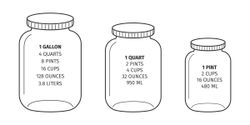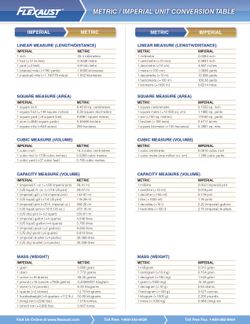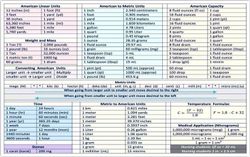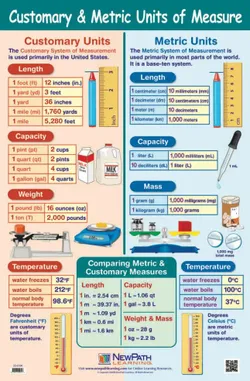Apr 18, 2023
Imperial vs Metric System





https://shop.worldwidemetric.com/conversion-calculator.asp
http://www.w4cll.com/convert.html
1. Imperial vs. Metric System
Visiting the USA, you’ll first notice differences as soon as your plane lands. Why did the airport weigh your baggage in pounds? Waiting for a taxi outside, you’ll also notice the speed limit signs in MPH (Miles Per Hour). What’s all that about? The U.S. is one of the few countries globally which still uses the Imperial system of measurement, where things are measured in feet, inches, pounds, ounces, etc. Most countries use the Metric system, which uses measuring units such as meters and grams and adds prefixes like kilo-, milli- and centi- to count orders of magnitude.
2. Why Imperial and Not Metric?
The Imperial System is also called The British Imperial because it came from the British Empire that ruled many parts of the world from the 16th to the 19th century. After the U.S. gained independence from Britain, the new American government decided to keep this type of measurement, even though the metric system was gaining in popularity at the time. We are one of the few countries in the world that still use this system, and first-time visitors can find it confusing. If you ask someone for directions, they will probably tell you something is a certain number of miles away. Or you may be told to move a few feet. But, whose feet?
3.
1 mile equals 1.6 Kilometers
Many cars will show miles and kilometers on the speedometer
1 foot (12 inches) is equal to 30 centimeters
1 inch is about 25 millimeters or 2.54 centimeters
A 3-foot measurement is almost exactly 1 meter
But keep in mind that it’s not an exact 3:1 ratio!
1 Kilogram is just over 2 pounds
4.
1 pound is about 454 grams
For U.K. visitors, 14 pounds = 1 stone
Fahrenheit vs Celsius
By the way, the temperature scales are different too. We didn’t want to make things too easy for you! Americans measure temperature in Fahrenheit, not Centigrade/Celsius. You may turn on the television and listen for the weather and hear that it is 70 degrees outside. No, you won’t pass out and be vaporized by the sun; 70 degrees Fahrenheit is actually very pleasant, about 21 degrees Celsius. Celsius has been used around the world from the mid 20th century, but again, Americans held fast to the original Fahrenheit system.
Many thermometers will show Celsius and Fahrenheit side-by-side.
5.
More conversions for temperature:
0 degrees Celsius is equal to 32 degrees Fahrenheit. (The freezing point)
24 degrees Celsius is equal to 75 degrees Fahrenheit. (A very pleasant day)
To convert Celsius (c) to Fahrenheit, use the formula (c x 1.8) + 32
There is no reason to expect that we will change over to the Metric System and Centigrade anytime soon. If you have a smartphone, you can download a conversion app. The company World Wide Metric has a comprehensive and easy to use conversion webpage.
6.
The imperial system and the metric system are two different measurement systems for things like distances, volumes, and weights. Since all countries in the world don’t use the same measurement system, it’s important to understand both.
What Is the Metric System?
The metric system is defined as:
“A decimal system of units based on the meter as a unit length, the kilogram as a unit mass, and the second as a unit time.”
Today, it is commonly referred to as SI, which stands for the Système International. It is also known as the International System of Units.
Countries Using the Metric System
All but three countries in the entire world use the metric system of measurement. Some of the major countries using the metric system include:
Australia
Canada
France
India
Italy
Japan
Mexico
South Africa
Spain
United Kingdom
7.
What Is the Imperial System?
The imperial system is defined as:
“A system of measurement in use in the United Kingdom and other Commonwealth countries consisting of units such as the inch, the mile and the pound (a unit of weight).”
The British Imperial System
The British Imperial System was the official weights and measures system used in Great Britain from 1824 to 1965. The system developed as a way to unite the country by having a single measurement system rather than the many local measurement systems.
The United States Customary System (USCS) was based on the British Imperial System, and many use the term “imperial system,” or IS, to describe both of these systems today.
8. Countries Using the Imperial System
So many countries use the metric system, it might leave you wondering, “Who still uses the Imperial system?” Only three countries in the world use an Imperial system of measurement:
Liberia
Myanmar
United States of America
Why Doesn’t the U.S. Use the Metric System?
When the USCS was created, the metric system was not as widespread as it is today. Since all industries in the U.S. were set up using this measurement system, it would take a lot of time and money for businesses, manufacturing plants, and the country’s infrastructure to change course. Switching an entire country to the metric system can take decades.
While the U.S. doesn’t officially use the metric system, it is widely taught in U.S. schools, and many measurement tools include both IS and SI units. U.S. packaging for commercial products is also mandated to show net quantities in both SI and USCS units.
9.
Main Differences Between Metric System and Imperial System
While the main difference between the metric system and the imperial system is the type of units used, there are a few other key differences.
The metric system is based around the unit of measurement called the meter.
The meter was created using the earth’s circumference as it runs from the North Pole, through Paris, France and to the equator.
Metric units easily convert by multiplying or dividing by powers of 10.
There is no straightforward way to convert imperial units.
The names and sizes of the measurement units used in each system are mainly what make them different. These are some of the units used for different measurements in each system.
10.
Is the Metric System Better Than the Imperial System?
You could argue that the metric system is better in today’s world because it is an almost universal standard that is understood no matter where you are. The metric system is also easier to use because of the way all measurements relate to each other. However, if you’re used to using the imperial system, you could argue it is more familiar and therefore easier to use.
Measuring Up
Now that you have a basic understanding of the metric system vs. the Imperial system, you can learn more details about each. Explore metric system prefixes to see how you can easily understand metric units, then discover measurement abbreviations for common measurements.
VOLUME
1 milliliter = 0.034 US fluid ounces
1 liter = 1 US quart (liquid)
LENGTH
1 meter = 39.37 inches, about 3 feet
1 centimeter = 0.39 inches
1 millimeter = 0.039 inches (to approximate, divide by 25)
AREA
1 square meter = 1.2 square yards, or 10.76 square feet
1 square centimeter = 0.155 square inches
12. WEIGHT/MASS
1 gram = 0.035 ounces (weight)
1 kilogram = 2.2 pounds
TEMPERATURE
To convert Celsius to Fahrenheit, multiply the temperature in degrees celsius by 9/5, then add 32 (freezing is 0°C and 32°F).
Some common metric conversions for baking are:
130°C = 250°F
150°C = 300°F
190°C = 375°F
200°C = 400°F
230°C = 450°F
U.S. and imperial units of Measurement
Type of Measurement Unit Abbreviation
Weight Pound lb. or #
Weight Ounce oz.
Volume Gallon gal.
Volume Quart qt.
Volume Pint pt.
Volume Cup c.
Volume Fluid ounce fl. oz. or oz.
Volume Tablespoon Tbsp. or tbsp.
Volume Teaspoon tsp.
Length Mile m.
Length Yard yd.
Length Foot ft. or ′
Length Inch in. or ″
13. Common Imperial Conversions In Cooking
1 tablespoon = 3 teaspoons
1 cup = 16 tablespoons
1 cup = 8 fluid ounces
1 pint = 2 cups
1 quart = 4 cups = 2 pints
1 quart = 32 fluid ounces
1 gallon = 4 quarts
1 gallon = 16 cups
1 gallon = 128 fluid ounces
1 pound = 16 ounces
Table 6: U.S. and imperial units of measurement
Type of Measurement Unit Abbreviation
Weight Pound lb. or #
Weight Ounce oz.
Volume Gallon gal.
Volume Quart qt.
Volume Pint pt.
Volume Cup c.
Volume Fluid ounce fl.oz. or oz.
Volume Tablespoon Tbsp. or tbsp.
Volume Teaspoon tsp.
Length Mile m.
Length Yard yd.
Length Foot ft. or ′
Length Inch in. or ″
14. Note: There is sometimes confusion about the symbol #. When # is used in front of a number, such as in #10, the # is read as the word number. Thus, #10 is read as number 10. When the # follows a number, the # is read as pounds. Thus, 10# is read as 10 pounds.
Differences between the U.S. and Imperial Systems
The only difference between the imperial system and the U.S. system is in volume measurements. Not only are the number of ounces in pints, quarts, and gallons all larger in the imperial system, the size of one fluid ounce is also different, as shown in the table in Table 7.
Table 7: Differences between U.S. and imperial volume measurements
Unit of Measurement Imperial System Metric Equivalent U.S. System Metric Equivalent
1 ounce 1 (fluid) oz. 28.41 mL 1 (fluid) oz. 29.57 mL
1 gill 5 (fluid) oz. 142.07 mL Not commonly used
1 cup Not commonly used 8 (fluid) oz. 236.59 mL
1 pint 20 (fluid) oz. 568.26 mL 16 (fluid) oz. 473.18 mL
1 quart 40 (fluid) oz. 1.137 L 32 (fluid) oz. 946.36 mL
1 gallon 160 (fluid) oz. 4.546 L 128 (fluid) oz. 3.785 L
15. Where you will notice this most is with any liquid products manufactured in Canada; these products will show the metric conversion using imperial measurement, but any products originating in the United States will show the conversion using U.S. measurements. For example, if you compare 12 fl. oz. bottles or cans of soft drinks or beer, you will see that American brands contain 355 mL (12 fl. oz. U.S.) and Canadian brands contain 341 mL (12 fl. oz. imperial).
If you are using a recipe written in cups and ounces, always verify the source of your recipe to determine if it has been written using the U.S. or imperial system of measurement. The difference in volume measurements can be quite noticeable when producing large quantities.
If the recipe is from the United States, use U.S. measurements for the conversion, if the recipe originated in the United Kingdom, Australia, or any other country that was once part of the British Empire, use imperial for the conversion.
16. Converting between Units in the Imperial and U.S. Systems
On occasion, you may need to convert between the various units of volume and between units of volume and units of weight in the U.S. system. To do this, you must know the equivalents for each of the units as shown in Table 8.
Table 8: Equivalent measures within the U.S. and Imperial system
Types of Measurement Conversion
Weight 1 pound = 16 ounces
Volume (U.S.) 1 gallon = 4 quarts or 128 (fluid) ounces
Volume (U.S.) 1 quart = 2 pints or 4 cups or 32 (fluid) ounces
Volume (U.S.) 1 pint = 2 cups or 16 (fluid) ounces
Volume (U.S.) 1 cup= 8 (fluid) ounces or 16 tablespoons
Volume (U.S.) 1 (fluid) ounce = 2 tablespoons
Volume (U.S.) 1 tablespoon = 3 teaspoons
Volume (imperial) 1 gallon = 4 quarts or 160 (fluid) ounces
Volume (imperial) 1 quart = 2 pints or 40 (fluid) ounces
Volume (imperial) 1 pint = 20 (fluid) ounces
Volume (imperial) 1 gill = 5 (fluid) ounces or 10 tablespoons
Volume (imperial) 1 (fluid) ounce = 2 tablespoons
Volume (imperial) 1 tablespoon = 3 teaspoons
Length 1 mile = 1760 yards
Length 1 yard = 3 feet
Length 1 foot = 12 inches
Note: One fluid ounce (usually called, simply, ounce) of water weighs approximately one ounce.
To convert from one unit to another, you either divide or multiply, depending on whether you are converting a smaller unit to a larger one, or a larger unit or to a smaller one.
17. Converting Smaller to Larger Units
To convert from a smaller to a larger unit, you need to divide. For example, to convert 6 tsp. to tablespoons, divide the 6 by the number of teaspoons in one tablespoon, which is 3 (see Table 8).
6 tsp = __ tbsp.
6 ÷ 3 = 2
6 tsp. = 2 tbsp.
To convert ounces to cups, you need to divide by 8 since there are 8 oz. in 1 cup. For example, if you need to convert 24 oz. to cups, you have to divide 24 by 8.
24 oz. = __ cups
24 ÷ 8 = 3
24 oz. = 3 cups
Converting Larger to Smaller Units
To change larger units to smaller, you have to multiply the larger unit by the number of smaller units in that unit. For example, to convert quarts to pints, you have to multiply the number of quarts by 2 because there are 2 pts. in 1 qt. Therefore, to convert 6 qts. to pints you need to multiply:
6 qts. = __ pts.
6 × 2 = 12
6 qts. = 12 pts.
To convert cups to tablespoons, you need to multiply by 16 since there are 16 tbsp. in 1 cup.
3/4 cup = __ tbsp.
16 × 3/4 = 12
3/4 cup = 12 tbsp.
18. Converting between Metric and Imperial/U.S. Measurement Systems
You can convert between metric and imperial or U.S. measurements with straightforward multiplication or division if you know the conversion ratios. Table 9.1 and 9.2 are a good reference, but there are also many online converters or apps available to make this task easier.
Table 9.1: Convert from metric to imperial/U.S.
When you know Divide by To get
millilitres 4.93 teaspoons
millilitres 14.79 tablespoons
millilitres 28.41 fluid ounces (imperial)
millilitres 29.57 fluid ounces (U.S.)
millilitres 236.59 cups
litres 0.236 cups
millilitres 473.18 pints (U.S.)
litres 0.473 pints (U.S.)
millilitres 568.26 pints (imperial)
litres 0.568 pints (imperial)
millilitres 946.36 quarts (U.S.)
litres 0.946 quarts (U.S.)
millilitres 1137 quarts (imperial)
litres 1.137 quarts (imperial)
litres 3.785 gallons (U.S.)
litres 4.546 gallons (imperial)
grams 28.35 ounces
grams 454 pounds
kilograms 0.454 pounds
centimetres 2.54 inches
millimetres 25.4 inches
19. Celsius (Centigrade) multiply by 1.8 and add 32 Fahrenheit
Table 9.2: Convert from imperial/U.S. to metric
When you know Multiply by To get
teaspoons 4.93 millilitres
tablespoons 14.79 millilitres
fluid ounces (imperial) 28.41 millilitres
fluid ounces (U.S.) 29.57 millilitres
cups 236.59 millilitres
cups 0.236 litres
pints (U.S.) 473.18 millilitres
pints (U.S.) 0.473 litres
pints (imperial) 568.26 millilitres
pints (imperial) 0.568 litres
quarts (U.S.) 946.36 millilitres
quarts (U.S.) 0.946 litres
quarts (imperial) 1137 millilitres
quarts (imperial) 1.137 litres
gallons (U.S.) 3.785 litres
gallons (imperial) 4.546 litres
ounces 28.35 grams
pounds 454 grams
pounds 0.454 kilograms
inches 2.54 centimetres
inches 25.4 millimetres
Fahrenheit subtract 32 and divide by 1.8 Celsius (Centigrade)
Table 10 lists the most common U.S. measurements and metric units of measure, and their equivalents used in professional kitchens. Table 11 presents the conversion factors.
20. Table 10: Common Metric and U.S. conversions
Measurement type Unit Equivalent
Length 1 inch 25.4 millimetres
Length 1 centimetre 0.39 inches
Length 1 metre 39.4 inches
Volume 1 fluid ounce (U.S.) 29.57 millilitres
Volume 1 cup 237 millilitres
Volume 1 quart 946 millilitres
Volume 1 millilitre 0.034 fluid ounces
Volume 1 litre 33.8 fluid ounces
Weight 1 ounce 28.35 grams
Weight 1 pound 454 grams
Weight 1 gram 0.035 ounce
Weight 1 kilogram 2.205 pounds
Table 11: Metric and U.S. Equivalents and Conversions
Measurement type To convert Multiply by Result
Length Inches to millimeters 25.4 1 inch = 25.4 mm
Length Inches to centimetres 2.54 1 inch = 2.54 cm
Length Millimetres to inches 0.03937 1 mm = 0.03937 in.
Length Centimetres to inches 0.3937 1 cm = 0.3937 in.
Length Metres to inches 39.3701 1m = 39.37 in.
Volume Quarts to litres 0.946 1 qt. = 0.946 L
Volume Litres to fluid ounces (U.S.) 33.8 1 L = 33.8 oz.
Volume Quarts to millilitres 946 1 qt. = 946 mL
Volume Millilitres to ounces 0.0338 1 mL = 0.0338 oz.
Volume Litres to quarts 1.05625 1 L = 1.05625 qt.
Weight Ounces to grams 28.35 1 oz. = 28.35 g
Weight Grams to ounces 0.03527 1 g = 0.03527 oz.
Weight Kilograms to pounds 2.2046 1 kg = 2.2046 lb.
21. Soft Conversions
Many times, cooks will use what are called “soft conversions” rather than exact conversions, especially in small batch recipes where a slight variation can be tolerated, as it is often difficult to measure very fine quantities using liquid measures. This is a shortcut that can be used if you are faced with only a set of metric measuring tools and a U.S. recipe (or vice versa). Table 12 lists the common soft conversions.
Table 12: Soft conversions
Metric U.S. Measurements
1 millilitre 1/4 teaspoon
2 millilitres 1/2 teaspoon
5 millilitres 1 teaspoon
15 millilitres 1 tablespoon
30 millilitres 1 fluid ounce
250 millilitres 1 cup
500 millilitres 1 pint
1 litre 1 quart
4 litres 1 gallon
Types of Measurements Used in the Kitchen
There are three types of measurements used to measure ingredients and to serve portions in the restaurant trade. Measurement can be by volume, by weight, or by count.
22. Recipes may have all three types of measurement. A recipe may call for 3 eggs (measurement by count), 250 mL of milk (measurement by volume), and 0.5 kg of cheese (measurement by weight).
There are formal and informal rules governing which type of measurement should be used. There are also specific procedures to ensure that the measuring is done accurately and consistently.
Number or Count
Number measurement is only used when an accurate measurement is not critical and the items to be used are understood to be close in size.
For example, “3 eggs” is a common measurement called for in recipes, not just because 3 is easy to count but also because eggs are graded to specific sizes. Most recipes call for large eggs unless stated otherwise.
23. Numbers are also used if the final product is countable. For example, 24 premade tart shells would be called for if the final product is to be 24 filled tart shells.
Volume
Volume measurement is usually used with liquids or fluids because such items are awkward to weigh. It is also used for dry ingredients in home cooking, but it is less often used for dry measurement in the industry.
Volume is often the measure used when portioning sizes of finished product. For example, portion scoops are used to dole out vegetables, potato salad, and sandwich fillings to keep serving size consistent. Ladles of an exact size are used to portion out soups and sauces.
Often scoops and ladles used for portioning are sized by number. On a scoop, such a number refers to the number of full scoops needed to fill a volume of one litre or one quart. Ladles are sized in millilitres or ounces.
24. Weight
Weight is the most accurate way to measure ingredients or portions. When proportions of ingredients are critical, their measurements are always given in weights. This is particularly true in baking where it is common to list all ingredients by weight, including eggs (which, as mentioned earlier, in almost all other applications are called for by count). Whether measuring solids or liquids, measuring by weight is more reliable and consistent.
Weighing is a bit more time consuming and requires the use of scales, but it pays off in accuracy. Digital portion scales are most commonly used in industry and come in various sizes to measure weights up to 5 kg (11 lbs.). This is adequate for most recipes, although larger operations may require scales with a larger capacity.
The reason weight is more accurate than volume is because it takes into account factors such as density, moisture, and temperature that can have an effect on the volume of ingredients. For example, 250 mL (1 cup) of brown sugar (measured by volume) could change drastically depending on whether it is loosely or tightly packed in the vessel. On the other hand, 500 grams (17.63 oz.) of brown sugar, will always be 500 grams (17.63 oz.).
25. Even flour, which one might think is very consistent, will vary from location to location, and the result will mean an adjustment in the amount of liquid needed to get the same consistency when mixed with a given volume.
Another common mistake is interchanging between volume and weight. The only ingredient that will have the same volume and weight consistently is water: 1 L of water = 1 kg of water.
There is no other ingredient that can be measured interchangeably because of gravity and the density of an item. Every ingredient has a different density and different gravitational weight, which will also change according to location. This is called specific gravity. Water has a specific gravity of 1.0. Liquids that are lighter than water (such as oils that float on water) have a specific gravity of less than 1.0. Those that are heavier than water and will sink, such as molasses, have a specific gravity greater than 1.0. Unless you are measuring water, remember not to use a volume measure for a weight measure, and vice versa.
Example 4
1 L water = 1 kg water
1 L water + 1 L canola oil = 2 L of water and oil mixture (volume)
1 L water + 1 L canola oil = 1.92 kg (weight)
In order to convert your existing recipes that only call for volume measurement to weight, you will need to measure each ingredient by volume, weigh it, and then record the amount in your recipe. There are also tools that can help with this conversion.
Aqua-calc: Online Food Calculator is an online calculator has an extensive database of foods and can convert from volume to weight in both the metric and U.S. measuring systems.
Lee Valley Kitchen Calculator is a conversion calculator has the capacity to convert between weight and volume. It comes with an attached list of ingredients and their specific gravitational weights. It is, however, a list of only the most common ingredients and will not likely cover everything that a commercial kitchen uses.
By undefined
6 notes ・ 40 views
English
Elementary